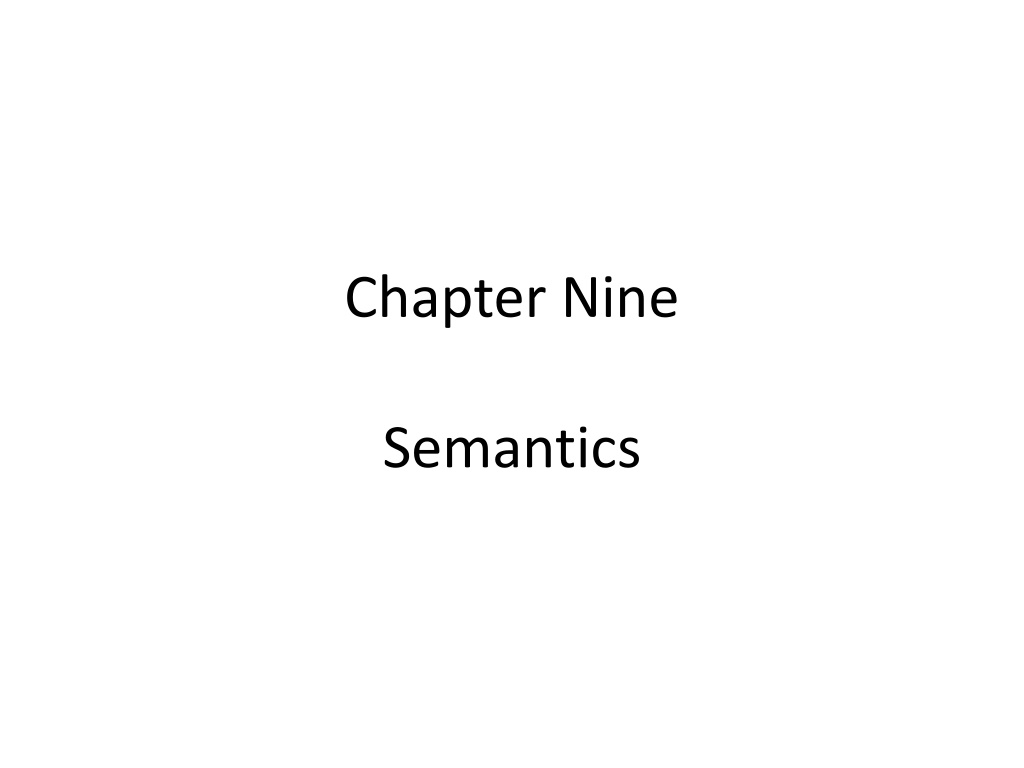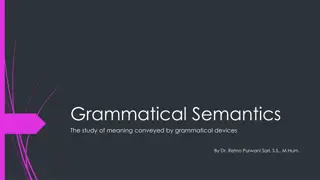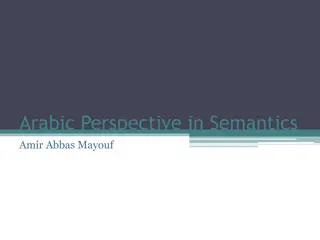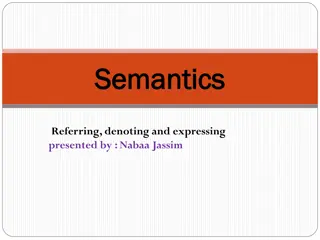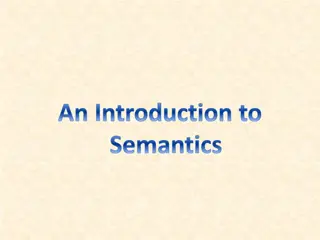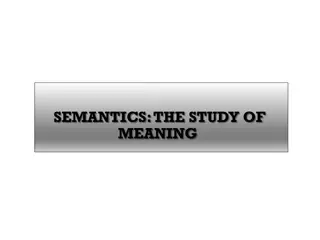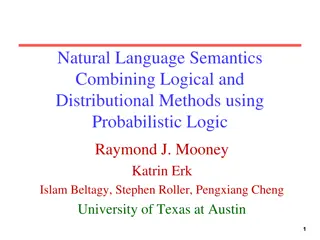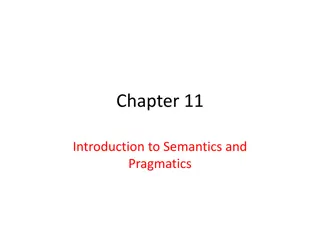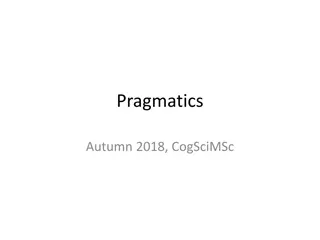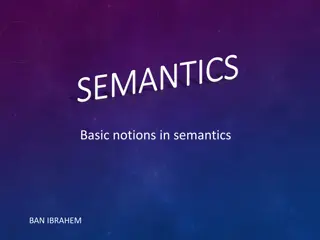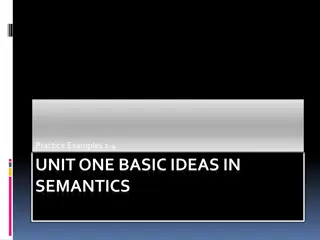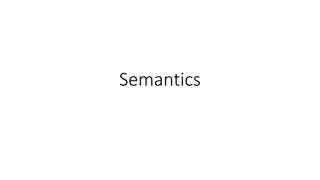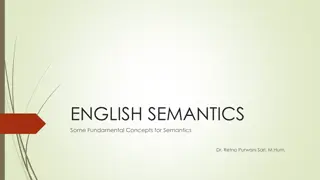Exploring Semantics: Meaning of Words and Concepts
Semantics is the study of the meaning of words, ranging from their basic literal components to their associative connotations. This branch of linguistics focuses on objective meaning shared by all rather than subjective interpretations. Concepts like conceptual and associative meanings are explained, along with semantic features that differentiate words based on their attributes such as animate or inanimate qualities. Understanding semantic elements allows for a deeper analysis of language structures and meanings.
Download Presentation

Please find below an Image/Link to download the presentation.
The content on the website is provided AS IS for your information and personal use only. It may not be sold, licensed, or shared on other websites without obtaining consent from the author. Download presentation by click this link. If you encounter any issues during the download, it is possible that the publisher has removed the file from their server.
E N D
Presentation Transcript
Chapter Nine Semantics
Semantics: is the study of the meaning of words, phrases and sentences. This approach is concerned with objective (or general) meaning and avoids the subjective (or individual) meaning. / i.e., it focuses on the knowledge of the meaning of words that we all share.
Meaning 1/ Conceptual meaning: Covers the basic components (literal meanings) of a word/ the type of meaning that dictionaries describe. E.g., the basic components of needle include thin, sharp, steel instrument. So, these components are part of the conceptual meaning of needle E.g., low-calorie (producing a small amount of heat or energy) 2/ Associative meaning: Connotations e.g., the word needle might be associated with pain or illness or blood or drugs etc. low-calories (healthy) Differ from one person to the next These associations are not part of the word s conceptual meaning. Literary writers, like poets, and advertisers are interested in associative meaning, however, in linguistics, semantics is more concerned with analyzing conceptual meaning.
Semantic Features E.g., The hamburger ate the boy The table listens to the radio. The horse is reading the newspaper. Notice that the oddness of these sentences is not derived from their syntactic structure/ they have well formed structures: NP V The hamburger ate the boy - So, the sentence is syntactically good but semantically odd. However, the following sentence is perfectly acceptable: - The boy ate the hamburger NP
To identify the source of the problem we have to look at the components of the conceptual meanings for both nouns: boy and hamburger because they must be different since one can be used as a subject for the verb ate while the other cannot. Obviously, the noun of the verb ate must be capable of eating Thus, we can determine the feature of meaning that any noun must have in order to be used as the subject of the verb ate, this feature can be referred to as an animate being We can describe the feature as either (+) meaning that the feature applies to the noun, or as (-) meaning that the feature does not apply to the noun E.g., boy is (+ animate) while hamburger is (- animate) Other examples of semantic features (+ human, - human) and (+female, -female) etc. Such features can be treated as basic elements that can be used for differentiating between the meaning of words in a language.
Semantic features table table horse Boy Man Girl woman animate - + + + + + human - - + + + + female - - - - + + adult - + - + - +
- Thus, we can say for example that the noun girl involves the feature (elements) [+human, +female, - adult] - We can supplement the syntactic analysis with semantic features: - The ________ is reading the newspaper. N [+human] - This approach would make it easier to identify which nouns make the sentence semantically odd , e.g., table, horse, hamburger. - Unfortunately, this approach cannot be applied to all words in the language, e.g., advice, threat, warning.
Semantic Roles Instead of thinking of words as containers of meaning, we can look at the roles they fulfill in the sentence, we call them semantic roles Semantic roles are also called thematic roles We recognize semantic roles of noun phrases in a sentence which describe the roles of entities (such as, people and things), unlike the verb which describes the action. E.g., The boy kicked the ball
Agent: The entity that performs the action E.g., the role taken by the boy in the boy kicked the ball. They are typically human, but they can also be non-human forces (the wind blew the ball away) or machines (the car ran over the ball) or creatures (the dog caught the ball) Agents and themes are the most common semantic roles: Theme: The entity that is involved in or affected by the action. E.g., the role taken by the ball in the same example. The theme can also be an entity that is simply being described. E.g., the ball in the ball was red. The theme is typically non-human but it can also be human the boy kicked himself the boy is agent and himself is theme
Instrument: - if an agent uses another entity in performing an action - e.g., the boy drew a picture with a crayon the noun phrase a crayon have the semantic role of an instrument. experiencer: When a noun phrase represents an entity as the person who has a feeling, a perception or a state/ if you see, or know or feel you do not really perform any action E.g., did you hear that noise the experiencer is you and the theme is that noise
Location: Where an entity is in the description of an event on the table in the room Source: Where an entity moves from (from Chicago) Goal: Where it moves to (to New Orleans) E.g., We drove from Chicago to New Orleans. the source is Chicago and the goal is New Orleans.
Examples Mary saw a mosquito on the wall She borrowed a magazine from George and she hit the bug with a magazine she handed the magazine back to George gee thanks , said George. Notice that a single entity George can appear in several different semantic roles
Lexical Relations Words can also have relationships with each other We usually explain the meanings of words in terms of their relationships E.g., conceal is the same as hide Shallow is the opposite of deep Daffodil is a kind of flower This approach is used in semantic studies and is referred to as the analysis of lexical relations, they include the following types
1/ Synonymy Synonyms: are two or more words with very closely related meanings They can often substitute for each other What was his answer? / What was his reply? Some common synonyms are called pairs E.g., almost/nearly, big/large, cab/taxi, freedom/ liberty Synonyms are not always in total sameness / sometimes one is more appropriate than the other Sandy had only one correct answer. (not reply) Synonyms can also differ in terms of formal vs. informal uses My father purchased a large automobile. (formal) My dad bought a big car. (informal/ casual)
2/ Antonymy Antonyms: two forms with opposite meanings e.g. of common antonyms, the pairs: alive/dead, big/small, fast/slow, hot/cold, male/female, true/false Divided into two types: 1/ Gradable antonyms: Opposites along a scale (big/small) Can be used in comparative constructions (I m bigger than you/ A pony is smaller than a horse) The negative does not necessarily apply to both antonyms (My car isn t old) doesn t mean (My car is new) 2/ non-gradable antonyms: Direct opposites Comparative constructions are not normally used/ we cannot say (John is deader than Mike)* The negative applies to both pairs of an antonym (My grandparents aren t alive) means that (My grandparents are dead) Other e.g. of non-gradable antonyms: male/female, married/single, true/false
3/ Hyponymy Hyponymy: when the meaning of one form is included in the meaning of another. We can consider connections between hyponyms in a diagram that can show visually the hierarchal relationship between them. (see p.118) From the diagram, horse is a hyponym of animal cockroach is a hyponym of insect animal and insect are called Superordinate (= having a higher level) Two or more words that share the same superordinate are called co-hyponyms. E.g., dog and horse are co-hyponyms under the superordinate animal. (give other examples from the diagram) The relation of hyponymy captures the concept of is a kind of E.g. the asp is a kind of snake
4/ Prototypes Prototype: the idea of the characteristic instance of a category./ i.e. the clearest example or the best representative of that category E.g., while the words (canary, penguin, robin, duck etc.) are all co- hyponyms of the superordinate bird they are not all good examples of bird / the most characteristic instance of the category is robin Also, chair can be considered the prototype of furniture/ shirt- clothing/ carrot-vegetable There is a general pattern to the categorization process and it determines our interpretation of word meaning (how much a word resembles the clearest example the prototype ) However, individual experience can lead to variations and people may disagree over the categorization of some words e.g. avocado is it a vegetable or a fruit?
Homophones and homonyms Homophones: when two or more different written forms (i.e. different spellings) have the same pronunciation E.g., bare/bear, meat/meat, flower/flour, right/write, to/too/two Homonyms: when one form has too or more unrelated meanings (same spellings). The following examples are homonyms. They are not related in meaning at all/ they have separate meanings but exactly the same form: Bank (of a river) / bank (financial institution) Bat (flying creature) / bat (for sports) Pupil (of the eye) / pupil (student) Race (contest of speed) / race (ethnic group)
Polysemy Polysemy: two or more words with the same form and related meanings. / i.e., one from having multiple meanings that are all related. E.g., head (top of the body/ foam on top of drinks/ person on top of a company) Foot (of person/bed/ mountain) Run (person/ water/ colors) If in doubt a word is an example of homonymy or polysemy best to check dictionary (if polysemy there will be a single entry with numbers for the different meanings/ if homonymy there will be two separate entries) (e.g. look up bat and head)
Word Play The last three lexical relations can be used for comical purposes, for example the polysemy of lamb is clear in the following: Mary had a little lamb Mary had a little lamb, some rice and vegetables. Why are trees often mistaken for dogs? (homonymy of bark ) Why is 6 afraid of 7? (homophones ate/eight)
Metonymy Metonymy: the type of relationship between words based on a close connection in everyday experience/ we can use one of these words to refer to the other, e.g., Container-content (bottle/water) Whole-part (car/wheels) (house/ roof) Representative-symbol (king/crown) (the president/ the white house) It is the familiarity with metonymy that helps us understand, e.g.: He drank the whole bottle The White House has announced. Giving someone a hand Answering the door.
collocation Collocation: words that tend to go with other words/ i.e. words that frequently occur together/ it is one way of organizing our knowledge of words, e.g., Hammer/nail Bread/butter Salt/pepper table/chair Corpus Linguistics: its a large collection of texts typically stored as a database in a computer. Linguists use this database to find out how often specific words occur together and what types of collocations are most common.
